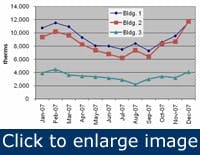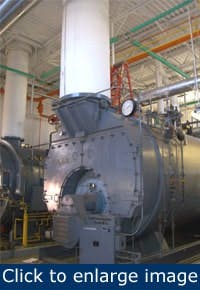Typically, we’re concerned with the components of the manufacturing plant and process. But let’s not forget about the offices that might be attached to the plant, or the offices at company headquarters. In either place, a dollar is a dollar, and saving energy in these office spaces can be just as important as saving energy in the plant.
The HVAC systems in many modern buildings rely on variable air volume (VAV) distribution. Research at the University of Illinois Smart Energy Design Assistance Center (SEDAC) indicates that a significant fraction of these systems consume excessive amounts of energy for reheat (perhaps as much as 50% more than necessary).
What’s the problem?
Variable air volume distribution systems were initially viewed as a way to eliminate the energy waste that commonly occurs in constant-volume systems with reheat that were previously found in many commercial and industrial buildings. Reheat is the addition of heat to previously cooled air. Reheat is used sometimes for humidity control, and sometimes for occupant comfort. The latter use happens when zone cooling loads are low and too much cold air is supplied to a space.
In a VAV system, a damper modulates the amount of cool air supplied to the zone. As the zone cooling load decreases, the damper begins to close, supplying less cool air. However, the damper can’t be allowed to close completely because the cooling air usually includes ventilation (outside air), and minimum amounts must be maintained. If the damper reaches its minimum stop and the zone load continues to decrease, the zone temperature is dropping below the setpoint. Then the reheat coil activates and the incoming cool air is reheated to maintain the setpoint.
HVAC system designers estimate loads for each building zone and then size the VAV system for that zone. The objective is to size it so that when the VAV system supplies its minimum air volume, the zone loads provide all reheat, either for humidity or comfort purposes.
Figure 1. Monthly natural gas consumption records for three typical buildings with variable air volume systems show significant natural gas consumption for reheat, particularly during the summer.
Unfortunately, VAV systems usually include a reheat coil. The coil is supplied with hot water or steam, or in some cases might use an electric resistance heater. The reheat coil acts as a shim, a backup in case the designer’s load estimate isn’t exact. Occupant comfort and humidity control still can be achieved through judicious use of reheat.
In real life, however, the VAV system reheat coils often use large amounts of energy. The reasons include grossly inaccurate load estimates, improper system installation and sizing, or failures in system hardware and software. Figure 1 provides an illustration of the magnitude of the problem. Each of the data sets depicts seasonal gas consumption for a modern building (constructed within the past eight years).
While the usage varies, in each case the buildings are consuming significant amounts of natural gas during the summer for reheat purposes. Notice that summer usage is close to 80% of the winter peak usage. The cooling systems in these buildings waste significant amounts of electrical energy as well, but this is more difficult to assess simply from the graphs of utility bills. The buildings represented here have annual energy costs of about $4/sf. We estimate that about $2/sf of that cost is attributable to reheat system deficiencies.
Figure 2. This 600-bhp boiler was being operated during summer only to supply the reheat coils
Every facility manager who operates office HVAC or plant space conditioning systems that incorporate reheat should be on the lookout for the problem shown in Figure 1. Plot the monthly gas consumption for each building or facility to see if you’re burning excessive natural gas during the spring, summer and fall. At the least, spend some time talking with the boiler plant operators. When we visited the plant shown in Figure 2, the first words out of the operator’s mouth were about the craziness of having to operate the boiler during the summer. In terms of energy efficiency, reheat waste is low-hanging fruit, on a par with lighting.
The University of Illinois Smart Energy Design Assistance Center is evaluating strategies for diagnosing reheat system problems in real time and determining methods for correcting the most likely sources of malfunctions or design deficiencies. We plan to achieve this either through upgrades to existing building automation system (BAS) algorithms and instrumentation, or through development of advanced wireless sensors and instrumentation that can be retrofitted to buildings that lack BAS.
Both approaches will integrate information about VAV performance with information about building energy consumption. Real-time methods are essential because reheat system failures frequently don’t result in occupant discomfort. Furthermore, owners and operators of buildings often lack the sophistication, time or interest to evaluate their utility bills in a meaningful manner. In the case of the buildings mentioned above, the owner was completely unaware of a problem of any kind in building performance.
Common causes for inefficiency
Our studies identified several modes of failure or design errors for VAV systems, all of which result in excessive reheat energy consumption
Oversizing: Intentional or accidental, oversizing occurs frequently when the designer doesn’t know the ultimate way a space in a building will be used. This situation occurs when developers are producing buildings for speculative purposes. The structure might be designed to accommodate uses ranging from office, retail, restaurant or even data center. The VAV system designer tends to design for the largest possible load, which can result in grossly oversized VAV terminal units. When these VAV boxes modulate their dampers to the minimum set points, there’s still an excessive amount of cool air being supplied, resulting in the need for reheat.
[pullquote]
Software failure: Many building automation systems have the basic software for control of VAV terminal units. We’ve found cases where that software contains errors that result in VAV terminal unit malfunction. In one case, the software correctly activated the reheat coil when the VAV box damper reached its minimum stop and the zone temperature was still below the setpoint. However, as the zone temperature rose and the damper lifted off its minimum point, the reheat coil wasn’t deactivated. Once the reheat coil was turned on, it remained on for the duration of the cooling season. The heating coil wasn’t inactivated until the heating season, when the zone temperature exceeded the set point. (As a point of interest, this occurred in an Energy Star-rated building.)
Mechanical malfunction:Our discussions with VAV control system vendors identified another possible error mode that we’ve not yet verified in the field. We asked vendors if the BAS could collect damper position data from the VAV terminal box. The reply was “Yes, but it isn’t a real number.” Apparently, the control system can lose track of the true damper position during power outages. Clearly, if damper position isn’t known accurately, reheat can occur any time the system “thinks” the damper is at its minimum stop.
Steps you can take
A valuable document, available from the Oregon Department of Energy (http://oregon.gov/ENERGY/CONS/Codes/docs/12-Airside_Controls.pdf), provides guidance for optimizing the performance of VAV systems that have reheat. Summarized below are some of the most useful techniques
Temperature control deadband: check your temperature control deadband, the range of temperatures in which the reheat coil won’t be activated even if the damper is at its minimum setting. Heating and cooling thermostat setpoints must be at least 5° apart. For example, if the cooling setpoint is 75°F and the damper has reached its minimum setting, the space temperature must drift below 70°F before the reheat coil can be activated.
Static pressure reset control: The amount of cool air delivered from each VAV terminal box depends on the damper position and the duct static pressure. Modulating the fan speed using a variable-frequency drive is a common way to maintain duct static pressure. Energy usage for fans and reheat coils can be minimized by resetting the static pressure setpoint downwards. You achieve the best control when you monitor the VAV box damper position for every zone and adjust the static pressure setpoint so that the damper in the most demanding zone is close to 100% open. This control method can partially offset the problems that occur when VAV boxes have been oversized. Reducing the static pressure setpoint reduces the amount of cool air delivered, the boxes don’t operate at their minimum stops and reheat might be avoided.
Temperature reset control: Implementing a supply air temperature reset control increases the supply air temperature at the main cooling coil. This technique can best be applied during the seasons when cooling loads might be below maximum, such as the spring, fall, and even winter for internal load-dominated buildings that cool year-round. A typical system designed for a supply air temperature of 55° and a space temperature of 75° should be capable of resetting the supply air temperature to 60°.
The bottom line
Energy and dollar savings achieved by optimizing VAV system reheat can be substantial. We estimate that when the VAV system fails, annual energy costs rise about $1.75 per square foot. At $1.00 per therm, this represents a waste of 1.75 therms per square foot per year. That’s plenty of incentive to invest in VAV tune-ups for even modestly sized buildings.
On a national level, the numbers are impressive. The USGBC estimates that 300 billion square feet of building space will be renovated or constructed during the next 30 years. Of that total, we estimate that about 150 billion will be served by VAV systems with reheat, and 75 billion of that will be served by VAV systems displaying the malfunctions described above.
Assuming 1.75 therms per square foot per year is wasted energy, at the end of 30 years about 131 billion therms per year of natural gas will be being wasted. As a point of reference, total annual natural gas consumption in the United States for all purposes is presently about 230 billion therms per year.
Beyond the simple dollars and cents, improvements in reheat operation significantly reduce the need for imports of natural gas and fuel oil used for heating. Greenhouse gas emissions associated with combustion of natural gas or oil for reheat will be greatly diminished. Electrical energy that cooling systems use when reheat is malfunctioning also will be significantly reduced, resulting in reductions in greenhouse gas emissions from fossil-fueled power plants.
A glimpse at the future
Our research to improve VAV performance might take several forms, depending on the end user’s HVAC system configuration. The most fundamental measure will be the integration of energy usage measurements with BAS system data or providing energy usage data through a separate system. In either case, the research product should allow the user to assess quickly whether conditions similar to those discussed above are occurring.
Our research will develop BAS software algorithms for monitoring and correcting key VAV system variables such as VFD fan modulation state, static pressure set points, cooled air supply temperature and thermostat deadband. For users without a BAS, we expect to be able to provide wireless sensors that can be retrofitted to existing VAV units to provide some of the functionality of a BAS. Also, we anticipate addressing the issue of the veracity of the measured VAV damper position by developing an add-on sensor or solving the issue of power loss on present VAV box damper measurement sensors.
Ben J. Sliwinski is a research specialist at the University of Illinois Building Research Council. Contact him at [email protected] and (217) 244-4394.


